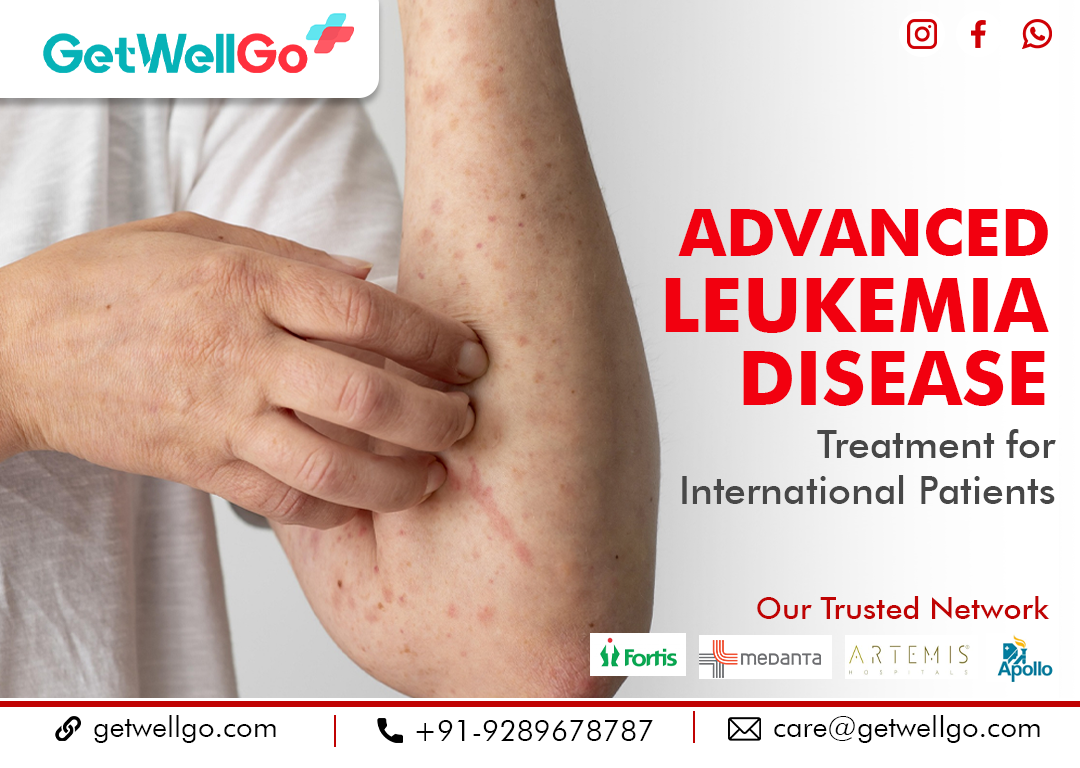Advanced Leukemia Disease Treatment for International Patients
Advanced leukemia treatment in India by GetWellGo offers affordable care for African patients, combining expertise and advanced technology to ensure better outcomes.

-
Category
General -
Published By
GetWellGo Team -
Updated on
11-Dec-2024
Leukemia Disease Treatment
Leukemia is a cancer that is characterized by unusual production of white blood cells in the blood and the bone marrow. Leukemia disease treatment depends on the type, (acute/chronic, lymphocytic/myelogenous), the patient’s age, general health, and the stage of cancer.
Symptoms of Leukemia
Symptoms of Leukemia can vary depending on the type and stage of the disease, but common signs include:
General Symptoms:
- Fatigue
- Fever
- Frequent Infections
- Unexplained Weight Loss
- Night Sweats
Blood-Related Symptoms:
- Easy Bruising or Bleeding
- Anemia Symptoms
- Slow Wound Healing
Pain and Swelling
- Bone or Joint Pain
- Swollen Lymph Nodes
- Abdominal Discomfort
Acute Myeloid Leukemia Treatments
Acute Myeloid Leukemia (AML) is a type of aggressive cancer that affects your bone marrow and blood. The treatment for acute myeloid leukemia is usually to eliminate the leukemia cells and to allow the body to produce normal blood cells.
Acute Myelogenous Leukemia Treatment
Acute Myelogenous Leukemia (AML) is a form of blood cancer that is fast progressing and starts in the bone marrow. It necessitates its aggressive management to reduce manifestations and encourage the state of remission. The acute myelogenous leukemia treatment depends on the genetic characteristics of the disease and the health status of a patient.
Acute Myeloblastic Leukemia Treatment
Acute Myeloblastic Leukemia (AML) is an acute myeloid leukemia in which bone marrow forms immature myeloblasts (abnormal white blood cells). This disease is ‘fast moving’, and often treatment will have to begin as soon as the doctor has diagnosed leukemia in an effort to slow down the proliferation of the leukemia cells. Acute myeloblastic leukemia treatment requires multi-modality approach with the intent to achieve remission, to consolidate remission and to avoid relapse.
Acute Monocytic Leukemia Treatment
Acute Monocytic Leukemia is also categorized under AML is defined by the rapid expansion of monocytic cells, a form of white Blood cell. The symptoms encountered include skin infiltration, gums enlargement, and central nervous system manifestations. Again, like most other types of AML, the acute monocytic leukemia treatment demands aggressive therapy.
AML Blood Cancer Treatment
Acute Myeloid Leukemia (AML) is one of the blood cancers and is featured by the feverish production of unhealthy myeloid cells from the bone marrow. AML blood cancer treatment is mostly proactive, with the ultimate goal of eradicating the disease and avoiding relapsing.
Treatments
The main treatment approaches include:
Chemotherapy
- Induction Therapy: The first goal of the treatment was to place the leukemia into a state of relapse. It uses very strong chemotherapy medications, mostly administered through an IV drip.
- Common drugs: Ara C, Daumorubicin, Idarubicin.
- Consolidation Therapy: This is done after remission in order to kill of any leukemia cells that may still be present but are too small to be seen.
- High-dose Chemotherapy: Occasionally given in individuals where there are chances that the client may relapse.
Stem Cell Transplant (Bone Marrow Transplant)
- Allogeneic Stem Cell Transplant: This is recommended for patients who are most likely to have a relapse. Those include but are not limited to; Auto-transplantation, in which the individual receives his/her own stem cells, deceased donors, in which stem cells are harvested from a deceased person, matched unrelated donor in which stem cells are taken from a stranger with close HLA match to the patient or family member in which stem cells are taken from a related but non-identical donor.
- Autologous Stem Cell Transplant: This is where the patient’s own stem cells are collected, stored and then modified by other processes to exterminate any existing malignant cells.
Targeted Therapy
- This treatment attacks particular changes or proteins on the leukemia cells’ DNA not allowing them to replicate.
- Examples of targeted therapies for AML
- FLT3 inhibitors (e.g., Midostaurin): Used for FLT3-mutated AML.
- IDH inhibitors (e.g., Enasidenib, Ivosidenib): For AML with IDH mutations.
- BCL-2 inhibitors (e.g., Venetoclax): Combined with chemotherapy especially for older patients or those with some accompanying diseases.
Immunotherapy
- Monoclonal Antibodies: These are man-made antibodies that can well fit on cancer cells and either kill them or give a sign to other parts of immune system to do so.
- CAR-T Cell Therapy: This involves tries to make a patient’s T Cells to be more effective in detecting leukemia. It is still being researched for the treatment of AML.
Radiation Therapy
- In some cases, radiation therapy is given when the leukemia cells invade the brain or any other part of the body.
- It may also be used before receiving stem cell transplant to help eliminate remaining cancerous cells.
Choose GetWellGo Go for Advanced Leukemia Disease Treatment
GetWellGo is regarded as a leading supplier of healthcare services. We help our foreign clients choose the best treatment locations that suit their needs both financially and medically.
We offer:
- Complete transparency
- Free online initial consultation
- Visa assistance
- 24 hour availability.
- Flight tickets assistance
- Complimentary Airport pick up and transfers
- Accommodation arrangement
- Assistance in selecting India's top hospitals for leukemia disease treatment.
- Case manager assigned for every patient to help in and out of hospital
- Medicines arranged without hassle at the lowest cost
- Suggestions of Native cuisine restaurants and delivery services
- Local SIM card & Forex services
- Expert oncologist with a strong track record of success
- Assistance during and after the course of treatment.
Contact Us Now!
Fill the form below to get in touch with our experts.
